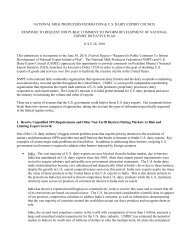Ben Smink - National Milk Producers Federation
Ben Smink - National Milk Producers Federation
Ben Smink - National Milk Producers Federation
Create successful ePaper yourself
Turn your PDF publications into a flip-book with our unique Google optimized e-Paper software.
PANEL: "THE USE OF ROBOTIC MILKERS ON DAIRY FARMS"<br />
<strong>Ben</strong> <strong>Smink</strong>,<br />
Lely USA Inc.,<br />
Pella Iowa, USA.<br />
Introduction<br />
The NMPF – Young Cooperator is taking time in the 2012 meeting to listen to experienced<br />
Automatic <strong>Milk</strong>ing System (AMS) users and ask them: 'How does AMS technology fit in the<br />
dairy industry'. For many dairy professionals automatic milking is considered a new technology,<br />
but for others AMS has become daily practice and many farmers have implemented AMS<br />
successfully with or without a steep learning curve. Implementing AMS on a dairy farm is not<br />
about how to milk cows, as the technology has proven itself over the past 20 years in Europe and<br />
the past 10 years in North America. In practice we see that implementing AMS has to do with<br />
proper herd management including a few key critical success factors.<br />
Experiences and key AMS success factors<br />
In a recent study, 57 North American Lely users shared their results and critical success factors<br />
following the implementation of AMS on their farm. (<strong>Smink</strong> et al., 2012). In general these<br />
farmers see increased milk production and a better handle on milk quality results, reproduction<br />
results and culling decisions. Key to their success can be brought back to four factors:<br />
1. Proper barn layout with great cow comfort, lots of space and open access to the AMS units.<br />
2. Good feed ration properly divided between the feed bunk and the robot feeders to make the<br />
robot an attractive place for the cows and to fulfill their individual nutritional needs.<br />
3. Professional guidance from experienced experts during the AMS transition period.<br />
4. Proper use of precision dairy management tools accompanying AMS systems.<br />
What is in it for the farmer: Precision Dairy Management tools in AMS<br />
Many studies focused on the value of one specific sensor in the AMS technology, as discussed in<br />
a number of papers in this symposium. What we have seen in practice is that the combination of<br />
information from multiple sensors is much more valuable. The total value of the information<br />
from the combination of sensors is more than the sum of the individual sensors. Modern AMS<br />
systems measure more than 100 values per cow per day in the robot, including: body weight,<br />
rumination, activity, feed intake and for each milking: milk yield, milk times, milk speed, milk<br />
temperature, fat, protein, lactose content and for each quarter: milk time, conductivity, color. All<br />
of this raw data is not necessarily useful, but with enhanced software algorithms data is
transformed to practical hands-on information. Herd managers get quick short overviews of<br />
attention cows only, including what the potential problem of the cow is and in which part of the<br />
body she is developing the problem. For instance, if we see high fat/protein ratio in combination<br />
with rumination drifting off, the program indicates ketosis. Or, if a cow shows normal milk<br />
production, normal conductivity and color of the milk in combination with high milk<br />
temperature, we know the cow is sick but not very likely caused by mastitis. For a typical<br />
mastitis case high detection rates are shown to be the combination of deviations in milk color,<br />
milk conductivity, quarter yield and quarter dead milk time. (Van der Tol, 2012)<br />
Multiple sensors in combination with the visual observation of naturally behaving cows in the<br />
robot barn enable the herdsman to see the abnormal individual in a much earlier stage. Therefore<br />
the herdsman can prevent the animal from getting sick before she starts loosing production. It is<br />
about being pro-active instead of re-active and about making better decisions to prevent cows<br />
drifting off (instead of making culling decisions after the problem got too severe). All of this<br />
improves constant health and therefore constant production, fertility and longevity results of the<br />
herd.<br />
Is it magic No of course not. If you are not a good cow person this information is not going to<br />
make you a good dairy farmer. At the end of the day the robot is just another way of milking<br />
(and spending your daily life) and not a magic herd management machine. An internal<br />
questionnaire with to the top 25 AMS producers out of the CRV BENELUX registration reports<br />
(DHI records The Netherlands, Belgium and Luxemburg), showed that the most important<br />
success factors are: best cow management practices and best cow comfort circumstances and not<br />
factors like type or age of the AMS barn.<br />
What is in it for the advisor: Precision Dairy Management tools in AMS<br />
On a higher level the dairy producer together with his advisors (nutritionists, veterinarians)<br />
benefit from this wealth of information on herd/pen/individual level to make better decisions on<br />
aspects like: feed rations, dry matter intake, effective fiber in the bunk, output feed truck, dry<br />
cow treatment, dry cow transition management, preventive mastitis treatment, et cetera.<br />
However, the advisor has to realize that the way to consult AMS producers is different. Farmers<br />
have all this information real time every hour of the day. So producers expect from advisors<br />
scenarios instead of evaluations. In the past, decisions were made on a monthly basis and based<br />
on milk sample results, which is similar to a tax paying process: you look at the outcome at the<br />
end of the period, pay your dues and pull a line to prevent this from happening in the future.<br />
Advisory on an AMS herd is more like a GPS navigation process: the farmer is expecting the<br />
advisor to give guidelines for the future which the farmer can select and apply immediately as<br />
the situation unfolds as he works his way through the coming month. As a result advisors will<br />
have to train producers how to use the summarized AMS information and translate that into daily<br />
action decisions. For many senior advisors it is scary to give that responsibility to the farmer: did
you trust the GPS the first time you used it Don’t be afraid, but keep an open mind for different<br />
ways of thinking.<br />
Take Home messages for the producer and his advisor<br />
North American dairy farmers who started their Lely AMS system in 2008/2010 recommended<br />
future AMS colleagues to: “Change daily management and use AMS information tools.”, “Have<br />
an experienced AMS nutritionist, because the feed ration is the key to success.”, “Visit other<br />
robot farmers and learn from them.”, “Prepare yourself, take time to listen to AMS specialists,<br />
they have experience.” and “Prepare the herd for the transition: health, feeding, feet and cow<br />
comfort”. (<strong>Smink</strong> et al., 2012).<br />
Preparation is King. That is why excellent pro-active farm management support is critically<br />
important, especially before the AMS is arriving on the farm. It is a learning process for the<br />
farmer, his consultants and the other stake holders in the market. AMS is not a 'one size fits all',<br />
so we have to advise producers according to their own situation. Be pro-active instead of reactive<br />
and move away from evaluations and focus on scenarios.<br />
The dairy industry has to keep working on making all AMS information more user friendly, so<br />
that the farmers can drive their dairy car with their own navigation system. Why would we use<br />
pages of information in table format if one small graph tells the whole story<br />
At the end of the day it is the good cow guy who makes the dairy farm successful.<br />
References<br />
<strong>Smink</strong> B., P. Kool, R. van der Tol. 2012 Critical Success Factors Transitioning from<br />
Conventional to Automatic <strong>Milk</strong>ing in USA. Proc. <strong>National</strong> Mastitis Council 51 st Annual<br />
Meeting.<br />
Van der Tol R. , X. Song, P. Kool. 2012 Validation of a Clinical Mastitis Indicator. Proc.<br />
<strong>National</strong> Mastitis Council 51 st Annual Meeting.









